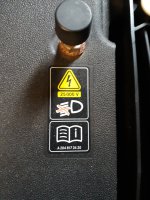It is not MY diagram, it is from a Haynes Manual, as I already stated.
it’s “your’ diagram in that you posted it.
A clamp meter measures AC current, not DC current so it will not work on a car to measure current. I presumed, foolish me, that you knew how to use a meter!
Now you see you keep posting things that make me think you know nothing about electronics at all. Even some really cheap clamps off amazon and ebay will measure DC amps
The Irony here being I used to work Largely between the 8800 bench meter 9100 calibrators and literally dozens of products in the Clamp meter division, We made custom Clamps for the automotive industry that would be used in testing cars electrical systems while it was moving down the production line, including the first clamp meter to use Bluetooth to talk to the computers that ran The production line. We used technologies you’d get in any commercially available clamp.
Is it just me, or can you not see that item 7 includes up to the dotted lines outside the blue. The visible link between C1 and B1 are internal to (7), not a direct shunt as is the connections between L7 and C9. As a result, the positive line from F31 goes through two circuits within the body computer, not bypassing them as you assume. Haynes, in their imagery, use both the dotted lines (as the outside of a module) plus the transistor symbol to signify that it is computer controlled.
Just for you. I foolishly assumed that you knew how to read a circuit / wiring diagram.
This isn’t a circuit diagram, its a rough representation of the circuits in the system, Haynes do not do proper circuit diagrams they do simplified diagrams for DIYers.
The dotterel line represents the body computer, where i have highlighted, shows that internally the measuring circuits that check for a failed bulb are internally isolated. All that shows is there is an internal connection to the computer but it’s not showing the circuits in that computer. The line I have drawn shows the power for the reverse light goes in and then straight back out again, I am not sure how else you thing this would be achieved ?
Now, something that you are ignoring is that most reversing cameras are plastic, mounted outside in the rain etc, usually proud of the rear of the car, and are usually not IP rated. They can be the first item damaged in a crash - i.e. reversing into a wall / pole presuming the image is further away than it actually is. Home installed cameras are not usually scaled similar to factory fitted ones.
So what ?? In this case the wire in question was passing through a grommet behind the bumper and open to the elements and uncapped.
Any minor bump to the back of the car, or any water up behind the bumper or corrosion it was/is likely to be just as vulnerable.
If someone puts a cheap camera on their car and powers the actual camera from the reverse light rather than just using it as a signal, and it causes problems with there reverse light, because they reverse into a wall or park it in a lake, then fuse 31 will blow and that’s very much there issue.
Water is electroconductive
yet again saying things that make me question you know what you’re talking about. ions are electrically conductive. Water is an insulator.
and to me that is idiotic.
Then you can feel free to not install a reverse camera on your car.
View attachment 428738
Here is another version of circuit diagram including the body computer (7) identifying L7 as a connection (similar to my prior post) but this time it is not connected to pin C9. Also, pin C6 doesn't seem to be connected to anything in the body computer! Also, this identifies I35 and I36 as the can bus of the body computer, where the arrows indicate the signals are being sent from the body computer and not to it.
One cannot assume that a link within a box is a direct shunt as it could be via an unlisted component.
No idea what you’re trying to show here? As stated above haynes makes diagrams that represent the way things are laid out but are not an accurate circuit diagram showing all the components within that module or computer. The fact that this diagram differs from the previous one should be enough to tell you that they are not consistently accurate drawings?
At this stage you’re just arguing for the sake of arguing, trying to dig yourself out of a hole, and in doing so you keep highlighting that you don’t seem to know all that much about electronics, and turn to personal insults when you run out of structured argument.
I quoted you way back, where you said something about putting 10M ohm on your body computer and seeing how long it lasts, this shows you fundamentally don’t understand Ohms law. You don’t know that clamp meters can measure DC amps, you think that a Haynes diagram is an accurate representation of the inner workings of a body computer. I’d probably give up now if i were you.



